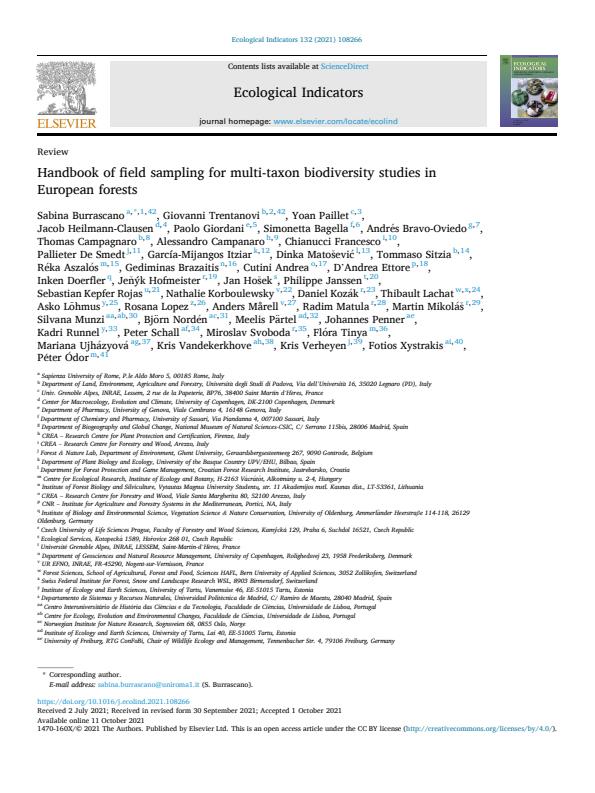Handbook of field sampling for multi-taxon biodiversity studies in European forests
Details
| Aantal pagina's | 13 |
|---|---|
| Volume | 132 |
| Type | A1: Web of Science-artikel |
| Categorie | Onderzoek |
| Tijdschrift | Ecological Indicators|Ecological Indicators online |
| Issns | 1470-160X|1872-7034 |
| Uitgeverij | Elsevier Science |
| Taal | Engels |
Bibtex
@misc{7a169da4-ebd5-4ee8-a78a-92b49ff5196e,
title = "Handbook of field sampling for multi-taxon biodiversity studies in European forests",
abstract = "Forests host most terrestrial biodiversity and their sustainable management is crucial to halt biodiversity loss. Although scientific evidence indicates that sustainable forest management (SFM) should be assessed by monitoring multi-taxon biodiversity, most current SFM criteria and indicators account only for trees or consider indirect biodiversity proxies. Several projects performed multi-taxon sampling to investigate the effects of forest management on biodiversity, but the large variability of their sampling approaches hampers the identification of general trends, and limits broad-scale inference for designing SFM. Here we address the need of common sampling protocols for forest structure and multi-taxon biodiversity to be used at broad spatial scales. We established a network of researchers involved in 41 projects on forest multi-taxon biodiversity across 13 European countries. The network data structure comprised the assessment of at least three taxa, and the measurement of forest stand structure in the same plots or stands. We mapped the sampling approaches to multi-taxon biodiversity, standing trees and deadwood, and used this overview to provide operational answers to two simple, yet crucial, questions: what to sample? How to sample? The most commonly sampled taxonomic groups are vascular plants (83% of datasets), beetles (80%), lichens (66%), birds (66%), fungi (61%), bryophytes (49%). They cover different forest structures and habitats, with a limited focus on soil, litter and forest canopy. Notwithstanding the common goal of assessing forest management effects on biodiversity, sampling approaches differed widely within and among taxonomic groups. Differences derive from sampling units (plots size, use of stand vs. plot scale), and from the focus on different substrates or functional groups of organisms. Sampling methods for standing trees and lying deadwood were relatively homogeneous and focused on volume calculations, but with a great variability in sampling units and diameter thresholds. We developed a handbook of sampling methods (SI 3) aimed at the greatest possible comparability across taxonomic groups and studies as a basis for European-wide biodiversity monitoring programs, robust understanding of biodiversity response to forest structure and management, and the identification of direct indicators of SFM.",
author = "Sabina Burrascano and Giovanni Trentanovi and Yoan Paillet and Jacob Heilmann-Clausen and Paolo Giordani and Simonetta Bagella and Andrés Bravo-Oviedo and Thomas Campagnaro and Alessandro Campanaro and Chianucci Francesco and Pallieter De Smedt and García-Mijangos Itziar and Dinka Matošević and Tommaso Sitzia and Réka Aszalós and Gediminas Brazaitis and Cutini Andrea and D'Andrea Ettore and Inken Doerfler and Jeňýk Hofmeister and Jan Hošek and Philippe Janssen and Sebastian Kepfer Rojas and Nathalie Korboulewsky and Daniel Kozák and thibault Lachat and Asko Lõhmus and Rosana Lopez and Anders Mårell and Radim Matula and Martin Mikoláš and Silvana Munzi and Björn Nordén and Meelis Pärtel and Johannes Penner and Kadri Runnel and Peter Schall and Miroslav Svoboda and Flóra Tinya and Mariana Ujházyová and Kris Vandekerkhove and Kris Verheyen and Fotios Xystrakis and Péter Ódor",
year = "2021",
month = dec,
day = "01",
doi = "https://doi.org/10.1016/j.ecolind.2021.108266",
language = "Nederlands",
publisher = "Elsevier Science",
address = "België,
type = "Other"
}
Auteurs
Sabina BurrascanoGiovanni Trentanovi
Yoan Paillet
Jacob Heilmann-Clausen
Paolo Giordani
Simonetta Bagella
Andrés Bravo-Oviedo
Thomas Campagnaro
Alessandro Campanaro
Chianucci Francesco
Pallieter De Smedt
García-Mijangos Itziar
Dinka Matošević
Tommaso Sitzia
Réka Aszalós
Gediminas Brazaitis
Cutini Andrea
D'Andrea Ettore
Inken Doerfler
Jeňýk Hofmeister
Jan Hošek
Philippe Janssen
Sebastian Kepfer Rojas
Nathalie Korboulewsky
Daniel Kozák
thibault Lachat
Asko Lõhmus
Rosana Lopez
Anders Mårell
Radim Matula
Martin Mikoláš
Silvana Munzi
Björn Nordén
Meelis Pärtel
Johannes Penner
Kadri Runnel
Peter Schall
Miroslav Svoboda
Flóra Tinya
Mariana Ujházyová
Kris Vandekerkhove
Kris Verheyen
Fotios Xystrakis
Péter Ódor

